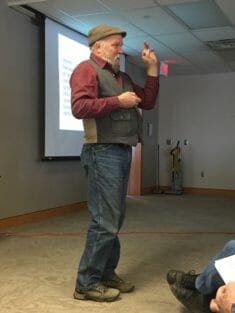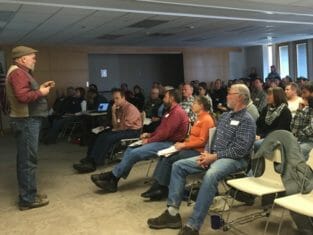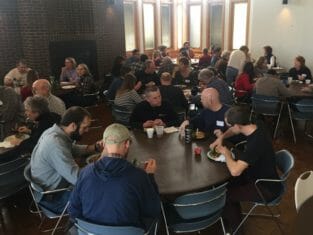Learning from Michael Phillips, the Holistic Orchardist
When the workshop originally scheduled for Saturday, February 21st was forced to be cancelled just three weeks before the date, we wondered if there was enough time to line-up something else. Thanks to the feedback from our Annual Conference attendees, we heard you loud and clear: Bring us an orchardist!
Luckily, we were able to convince Michael Phillips, renowned orchardist and author of The Holistic Orchard, to travel from his Lost Nation Orchard in New Hampshire to speak here in Iowa. He was admittedly a bit skeptical about us having only a couple weeks to promote the workshop, but within a week we closed registration at 100 attendees. Michael was impressed (and so were we!).
True to the name of the workshop–Successful Biological Orcharding– Michael spent the day explaining the fascinating and often overlooked biological connections that occur in a healthy orchard ecosystem.
All orchard systems will experience disease and insect pest pressure at some point—though some fruit varieties and locations will get it worse than others. Essentially you can choose to address these pressures with either an allopathic approach, as most orchards do by using fungicide and insecticide chemical sprays that treat or suppress symptoms, or you can build a holistic system that is able to withstand pest and disease pressures from within. It’s not black and white, however; even Michael Phillips’ holistic orchard system requires a spray plan (though his sprays include liquid fish, neem oil, seaweed extract and others of that nature).
His approach to growing fruit is to steer the orchard ecosystem toward imitating the forest edge, and to let natural fungal-dominated biological connections do the work for you. Without repeating the biological rationale behind Michael’s orchard management practices (which I couldn’t do if I tried), it all comes down to soil health, and my new favorite phrase: fungal duff. A healthy orchard system starts in the soil and the root systems, which is intimately tied to the understory. Piles of ramial wood chips and a fungal-dominated orchard compost mix (40:1 CN ratio), diverse clumps of tap-rooted plants (especially Bocking cultivars of Russian Comfrey) and blooming flowers—all planted and dumped haphazardly beneath the fruit trees—will provide an array of nutrient choices and environments for your trees’ feeder roots. Michael made it clear that this fungal duff is imperative for supporting healthy trees and berries.
The visible enthusiasm of attendees and lively conversation at breaks and lunch provided a great atmosphere for the event. Thanks to all the PFI members who helped set up tables and chairs (and put them away) – 200 hands make light work! We also enjoyed food from many PFI member farms, including apples from Wills Family Orchard (and Hoch Orchard), ham from Madsen Stock Farm, greens from Salama Greenhouse and Lee’s Greens, cheese curds and cream from Picket Fence Creamery, apple juice from Alexander Farm, and many types of jam shared by attendees.



